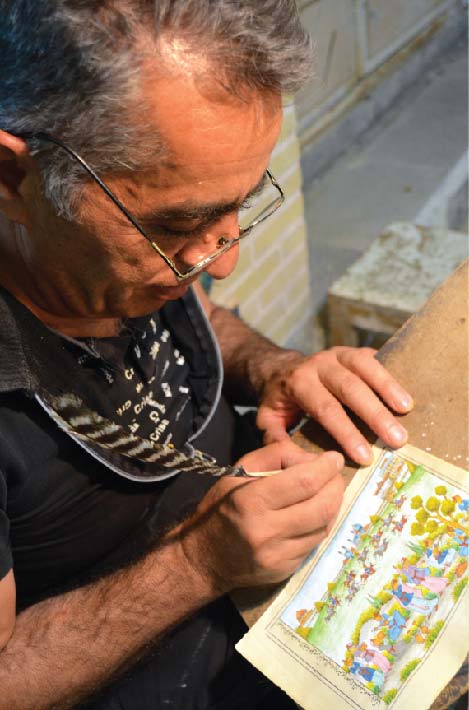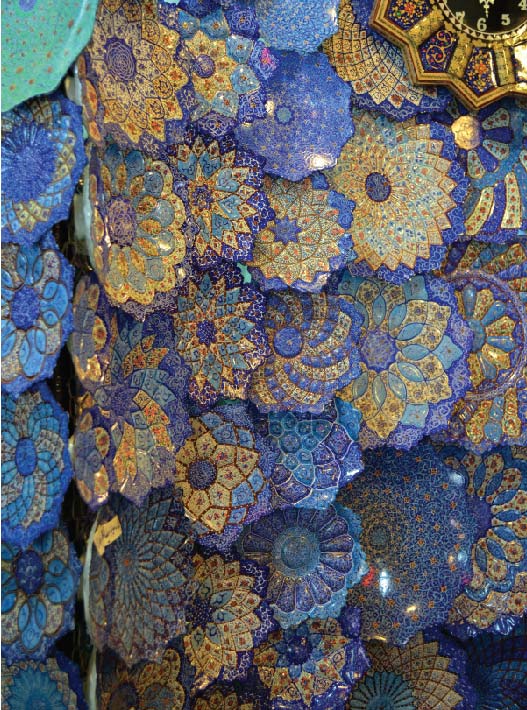Photographs by Zareef Cader
During my recent visit to Iran I was blown away by its art and architecture. Every aspect of life is beautified – be it the place of worship or utensils for everyday use. Even the food served is an array of colours, flavours and textures. Walking through bazaars with attached caravanserais and hammams, little seems to have changed in both architecture and ambiance.

The Middle Eastern Bazaar takes you back hundreds, even thousands of years. Its arched gateway of aged brick and stone with Muqarnas vaulted doorways and dimly lit allies are like a maze. You pass from the heat and glare of a big, open square into a cool, dark enclosure that extends as far as the eye can see, losing itself in the shadowy distance. The air is heavy with the smell of saffron, rose, spices and incense. From everyday produce to exotic handicrafts, there’s something for everybody in the bazaar.
The carpet
We have all heard about the quality and beauty of Persian rugs. Carpet weaving is one of the most distinguished forms of Persian art and dates back to ancient times. Weavers mix elegant patterns with a myriad of colours. The Iranian carpet is similar to the Persian garden, full of flowers, birds and beasts. Buying a carpet is no easy task; the price can range from $400 – $4000 for a medium size one. This greatly depends on the wool to silk ratio, the number of knots per square inch and the design.

The miniature painting
The paintings are usually done on small pieces of camel bone or paper and depict local iconic sites, fables and poems. The drawings are made from cat hairbrush with delicate lines that vary in width. The most masterful and expensive paintings are not necessarily large, but instead incredibly detailed. Persian miniatures use pure geometry, vivid palette of colours and are flat in form. The paintings give a visual reference to the literary plot which makes reading more enjoyable and easier to understand.
Pottery and tile work
Iranian pottery production presents a continuous history from the beginning to its present day. As we walk through the Imam Shah Mosque, the workshop of tile masons show us an array of different tiles ready to be sold to anyone who is willing to carry the heavy load back home. Tile mosaic is a meticulous technique where glazed tiles are cut and interlocked into complex designs of geometrical and foliate motifs. While the overgrazed painted tiles are relatively easier to make, the designs are painted in coloured glazes and fired. The colours are kept separate by outlines known as ‘dry cord’.


Mirror works
Mirror art is one of the most delicate architectural decorations in Islamic Iran. It is an art made of regulated shapes in various designs and images with small and big pieces of mirror. As the story goes, in the 10th century when mirrors were imported from Venice, the broken pieces of a mirror were cut into shapes and reused as a new decorative form to avoid waste. In the bazaar of Shiraz, artists create such memorabilia for tourists who want to bring home a piece of Iran.
Calligraphy
The significance of the art of calligraphy in works of pottery, metallic vessels and historic buildings is all that the eye can see in Iran. An illumination in the Quran was a classic Persian art, which introduced many new fonts and styles such as Nasta’liq, Naskh and Mohaqqaq among others. In the bazaars you can buy an illuminated hand written Quran ranging from $600 for copies that are over eighty years old. But the most popular forms of calligraphy are verses from famous Persian poets written in calligraphic Farsi.
Metalwork & Painted Enamelware
The sounds of tapping and tinkering fill the halls of the bazaars as we walked through the metal section. Sparkling plates, vases, cups, and trays made of silver, tin, copper are richly decorated with inlaid metals using calligraphy, arabesque and geometric decorations. The enamelware goes through a whole second process after the object is moulded out of copper. Once it is formed, it is then coated in a white primer and hand painted with delicate designs and finally heated again. Much like the miniature painting, the finer and more detailed the design, the more expensive it is. The skill and workmanship is evident in the attention to detail and the process is fascinating to watch.

Khatam-kari
One of my first purchases was one such box. Khatam-kari is the process of combining different coloured woods, bone and metals into geometric patterns that are then applied to boxes, tables, frames, chessboards and clocks. The surface is then sanded smooth with a varnished shiny lustre. Imitation pieces are plentiful best way is to scratch or sand the surface to check if the pattern comes off.
The bazaar is a great place to see Islamic art in the making. It is the thread of continuity from past to present, exhibited in a forum where a society meets and intermingle in goods, art and ideas.

